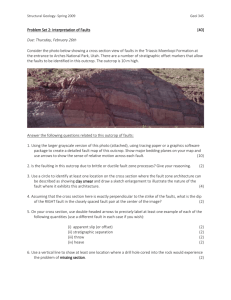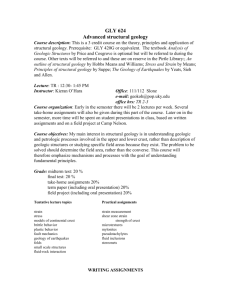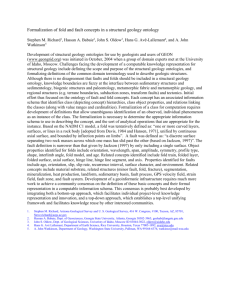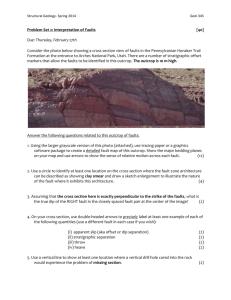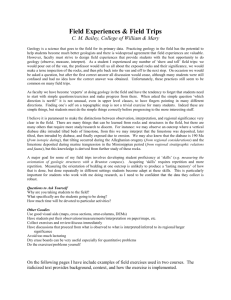Teaching Structural Geology – Field Day 1
advertisement
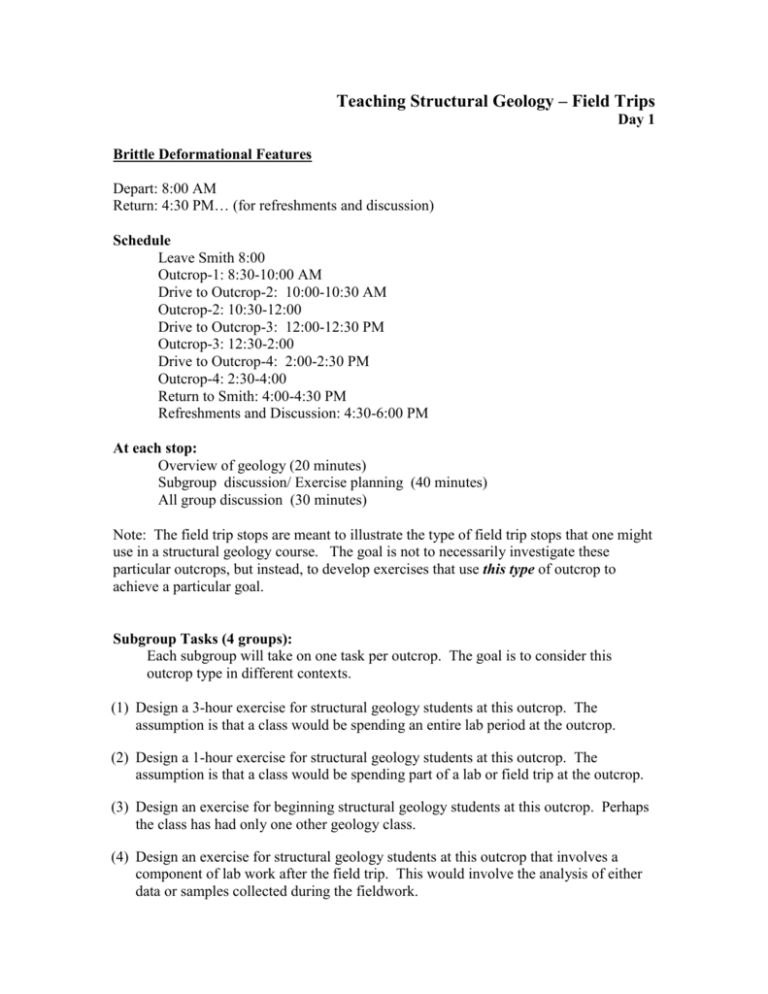
Teaching Structural Geology – Field Trips Day 1 Brittle Deformational Features Depart: 8:00 AM Return: 4:30 PM… (for refreshments and discussion) Schedule Leave Smith 8:00 Outcrop-1: 8:30-10:00 AM Drive to Outcrop-2: 10:00-10:30 AM Outcrop-2: 10:30-12:00 Drive to Outcrop-3: 12:00-12:30 PM Outcrop-3: 12:30-2:00 Drive to Outcrop-4: 2:00-2:30 PM Outcrop-4: 2:30-4:00 Return to Smith: 4:00-4:30 PM Refreshments and Discussion: 4:30-6:00 PM At each stop: Overview of geology (20 minutes) Subgroup discussion/ Exercise planning (40 minutes) All group discussion (30 minutes) Note: The field trip stops are meant to illustrate the type of field trip stops that one might use in a structural geology course. The goal is not to necessarily investigate these particular outcrops, but instead, to develop exercises that use this type of outcrop to achieve a particular goal. Subgroup Tasks (4 groups): Each subgroup will take on one task per outcrop. The goal is to consider this outcrop type in different contexts. (1) Design a 3-hour exercise for structural geology students at this outcrop. The assumption is that a class would be spending an entire lab period at the outcrop. (2) Design a 1-hour exercise for structural geology students at this outcrop. The assumption is that a class would be spending part of a lab or field trip at the outcrop. (3) Design an exercise for beginning structural geology students at this outcrop. Perhaps the class has had only one other geology class. (4) Design an exercise for structural geology students at this outcrop that involves a component of lab work after the field trip. This would involve the analysis of either data or samples collected during the fieldwork. Additional Goals/Objectives What type of student preparation should be done before the field trip? How can we bring microstructures into field? That is, how can we teach microstructural geology (and the value added by microstructures) while in the field? How to best get students to present observations-interpretations to the each other. Can we (should we) develop a situation where more advanced students teach the more beginning students? What additional goals should we list for a typical structural geology field trip? General Stop Types: Elementary Concepts Outcrop Turners Falls - lower: This is a sequence of dipping beds with primary structures, useful for teaching a number of basic concepts including: strike, dip, younging, apparent thickness, stereonet plotting, etc. Multiple Scales of Observation – Faults in the Field Turners Falls – upper: This type of outcrop allows students to study structures at multiple scales. Here a map scale fault-cuts a tilted basalt flow. A variety of scales of faults are present from meso-scale to micro-faults. At the finest scale, it is necessary to distinguish generations of fractures and their possible relationship to the large-scale fault. Basic Field Trip Stop Athol Fault: This is an example of a relatively straightforward field trip stop. It is an important example of a fault (fault surface) that all students “should” see. The goal is to make these outcrops more than just jump-out-of-the-van stops. Advanced Geological Concepts: - Rheological Properties Poplar Mountain Gneiss: This is an example of an outcrop that involves some relatively advanced geological concepts, in this case ductile flow and grain scale deformation mechanisms. The goal is to find a way for all students to take some insight from the outcrop. Elementary Concepts Outcrop - Turners Falls - lower: Exercises with simple dipping beds… This is a sequence of dipping beds with primary structures, useful for teaching basic concepts. Turners Fall Sandstone. Major concepts/components: strike and dip younging true and apparent thickness stereonet plotting right cross sections Notes: Use this space to make notes about the geology at this stop: Subgroup Discussion: Use this space to make notes concerning your specific exercise type (i.e. task): General discussion: Use this space to make notes from the general discussion about this stop: Multiple Scales of Observation – Faults in the Field Turners Falls – upper: This type of outcrop allows students to study structures at multiple scales. Here a map scale fault-cuts a tilted basalt flow. A variety of scales of faults are present from meso-scale to micro-faults. At the finest scale, it is necessary to distinguish generations of fractures and their possible relationship to the large-scale fault. See Figures 2,3. Major concepts/components: Faulting Slip vs. separation Topographic expression of faults Map evidence for faulting Minor faulting Fault/joint density Faults vs. joints Relative timing of fractures Characterizing small scale fault and joint surfaces Notes: Use this space to make notes about the geology at this stop: Subgroup Discussion: Use this space to make notes concerning your specific exercise type (i.e. task): General discussion: Use this space to make notes from the general discussion about this stop: Classic Field Trip Stop This is an example of a relatively straightforward field trip stop. It is an important example of a fault (fault surface) that all students “should” see. The goal is to make these outcrops more than just jump-out-of-the-van stops. Athol Fault: Mesozoic normal fault cutting Paleozoic metamorphic rocks (see Figure). The approximately 3m-wide fault zone contains a variety of fault zone features including silicified fault breccia, gauge, kinematic indicators etc (See Figures 4,5). Major Geologic Concepts: Fault nomenclature Normal faulting Fault zone (surface) features Also, fluids and faults – engineering and environmental geology Notes: Use this space to make notes about the geology at this stop: Subgroup Discussion: Use this space to make notes concerning your specific exercise type (i.e. task): General discussion: Use this space to make notes from the general discussion about this stop: Advanced Geological Concepts: - Rheological Properties Poplar Mountain Gneiss: This is an example of an outcrop that involves some relatively advanced geological concepts, in this case ductile flow and grain scale deformation mechanisms. The goal is to find a way for all students to take some insight from the outcrop (see Figure 5). Major Geologic Concepts: Ductile shearing/ shear zones Grain size reduction Dynamic recrystallization Deformation mechanisms P-T conditions of deformation Regional tectonics Notes: Use this space to make notes about the geology at this stop: Subgroup Discussion: Use this space to make notes concerning your specific exercise type (i.e. task): General discussion: Use this space to make notes from the general discussion about this stop: Substitute Stop: Quabbin Reservoir Spillway Polished outcrop surfaces with a variety of small-scale fractures (faults and joints).
